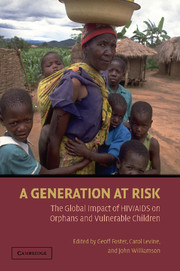Book contents
- Frontmatter
- Contents
- Foreword
- Preface
- Contributors
- Introduction: HIV/AIDS and Its Long-Term Impact on Children
- 1 Family and Community-Based Care for Children Affected by HIV/AIDS: Strengthening the Front Line Response
- 2 Strengthening Households and Communities: The Key to Reducing the Economic Impacts of HIV/AIDS on Children and Families
- 3 The Response of the Educational System to the Needs of Orphans and Children Affected by HIV/AIDS
- 4 Psychosocial Impact of the HIV/AIDS Epidemic on Children and Youth
- 5 Human Rights and Children Affected by HIV/AIDS
- 6 Religion and Responses to Orphans in Africa
- 7 Making the Right Choices in the Asia-Pacific Region: Protecting Children and Young People from HIV and Its Impacts
- 8 Troubled Tapestries: Children, Families, and the HIV/AIDS Epidemic in the United States
- 9 Interventions to Support Children Affected by HIV/AIDS: Priority Areas for Future Research
- 10 Finding a Way Forward: Reducing the Impacts of HIV/AIDS on Vulnerable Children and Families
- Chronology of Important Events
- Resource Guide
- Index
- References
Introduction: HIV/AIDS and Its Long-Term Impact on Children
Published online by Cambridge University Press: 05 June 2012
- Frontmatter
- Contents
- Foreword
- Preface
- Contributors
- Introduction: HIV/AIDS and Its Long-Term Impact on Children
- 1 Family and Community-Based Care for Children Affected by HIV/AIDS: Strengthening the Front Line Response
- 2 Strengthening Households and Communities: The Key to Reducing the Economic Impacts of HIV/AIDS on Children and Families
- 3 The Response of the Educational System to the Needs of Orphans and Children Affected by HIV/AIDS
- 4 Psychosocial Impact of the HIV/AIDS Epidemic on Children and Youth
- 5 Human Rights and Children Affected by HIV/AIDS
- 6 Religion and Responses to Orphans in Africa
- 7 Making the Right Choices in the Asia-Pacific Region: Protecting Children and Young People from HIV and Its Impacts
- 8 Troubled Tapestries: Children, Families, and the HIV/AIDS Epidemic in the United States
- 9 Interventions to Support Children Affected by HIV/AIDS: Priority Areas for Future Research
- 10 Finding a Way Forward: Reducing the Impacts of HIV/AIDS on Vulnerable Children and Families
- Chronology of Important Events
- Resource Guide
- Index
- References
Summary
HIV/AIDS has changed the world in profound and still-evolving ways. The last children born before HIV/AIDS emerged in the late 1970s and early 1980s are now in their mid-twenties, many with children of their own. All children born in the foreseeable future – at least for the next several decades – will be living in a world where the epidemic persists, albeit with variable consequences for each of them. Children, among the most vulnerable members of society, are bellwethers of adult leaders' willingness and capacity to respond to economic, health, and social challenges. What happens to children and adolescents now will determine not only their futures but also the futures of their families, communities, and societies.
In the first years of the HIV/AIDS epidemic, though, there was relatively little direct focus on children, particularly children who were not themselves HIV-infected but were nevertheless significantly affected by the disease. In the past decade or so the massive and growing number of orphans in Africa has received periodic media attention and many program responses. To be sure, in developed countries in North America and Europe, pediatric HIV/AIDS has become a highly sophisticated medical specialty. Treatments to reduce mother-to-child HIV transmission have succeeded extraordinarily well in these countries and are being introduced slowly in poor countries where the need is greatest. In every country affected by the epidemic, dedicated individuals and groups – most with very meager resources – serve children and families and advocate for more attention to their needs.
- Type
- Chapter
- Information
- A Generation at RiskThe Global Impact of HIV/AIDS on Orphans and Vulnerable Children, pp. 1 - 10Publisher: Cambridge University PressPrint publication year: 2005
References
- 4
- Cited by



